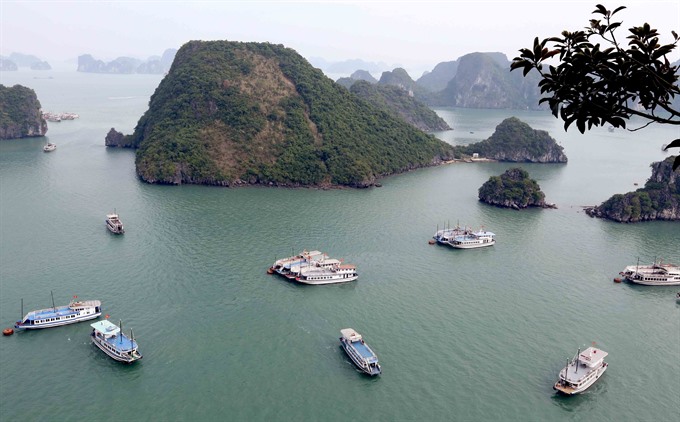The water environment in the world-renowned Hạ Long Bay has been under tremendous pressure from the growing socio-economic activities in the area.

Cruiseships operating in the Hạ Long Bay, the UNESCO-recognised heritage site in the northern province of Quảng Ninh. Wastewater discharge from these cruiships has been identified as a serious threat to the bay’s water environment. — VNA/VNS Photo Quang Quyết
Recognised twice by the UNESCO as the global heritage, Hạ Long Bay remains one of the country’s top attractions – drawing in 9.87 million tourists last year, of which, 4.28 million are foreign tourists, bringing in US$797 million in revenues, up 30 per cent against 2016.
Everyone it seems wants a slice of the pie with a boom in accommodation – 12,000 rooms, 80 hotels, and 512 cruises (including overnight ones).
Overload threats
Phạm Đình Huỳnh, deputy head of the Bay’s management board, said the international recognition of the Bay has been a boom to the province’s development but also causes a lot of troubles for the authorities.
Hạ Long Bay is not just a purely tourist site. Several vital socio-economic activities make use of the bay – marine transport route cuts through the Bay to move goods from Cái Lân Port to Hải Phòng Port and others, aquaculture activities on the water surface, in addition to the rapid expansion of coastal urban areas including the planned development of the special economic zone Vân Đồn.
Đặng Văn Bài, vice chairman of the Việt Nam’s Heritage Association, shared his concerns over whether the understaffed management board could be capable of overseeing the 438sq.km heritage area with 788 islands of various sizes.
The issue of wastewater involves many stakeholders, coming from different places, discharging different types of wastewater – coal mining, operations of fishing vessels, operations of hotels or restaurants – therefore, any unilateral action plan would not be effective, stressed Jake Brunner, programme co-ordinator of International Union for Conservation of Nature (IUCN) in Việt Nam.
Hồ Quang Huy, vice chairman of the provincial People’s Committee, acknowledged that the future of the bay depends on commitments to particular measures to safeguard its environment. Huy said that the province is hastening the building of legal frameworks to make sure a rigorous implementation of the environment master plan envisioned for the bay, as well as mechanisms for co-operation between competent bodies.
The role of community-based campaigns conducted by both the State organisations like youth’s union, women’s association, as well as civil societies are also underlined, with specific activities such as awareness raising campaigns held across schools in the area, or clean-up operations on the beach and over the waters.
Huy also said that in the future, the authorities will need to hold comprehensive water quality monitoring more frequently, at least once every three months, as well as more unannounced inspections to timely prevent violations.
Cruises’ wastewater
The operations of the hundreds of cruise ships in the Hạ Long Bay area inevitably results in bilge water, and the pollution threats from this oily mixture poses are so dangerous that three years ago, the province has ordered a halt on building any more tourist cruise, otherwise the number would not just be kept at the current 500-600 but might swell to thousands, Huỳnh said.
“Previously, with lax regulations, most cruises operated without supervision, only recently the province has started to enforce stricter rules, but at the moment, only 10 per cent of the cruises are outfitted with bilge water treatment system, while the remaining 90 per cent are old-schooled sailboats and could not be added such a system,” he said.
However, even so, according to IUCN, with experts’ estimating the daily wastewater discharge from cruises reaching some 502cu.m, a treatment system that is capable of handling the total amount of wastewater could cost around $3.1 million – $1.2 million for 12 boats for collecting bilge water, $800,000 for port-based treatment plants, and $500,000 for necessary on-board equipment for cruises. The daily operational cost for the entire system would come to $251 a day, which would require cruise operator to pay up to $5 per cu.m of wastewater handled.
Nguyễn Duy Phú, chairman of the Pelican luxury cruise company, said they have studied IUCN’s figures and concluded that the actual number of ships needed to collect bilge water from all cruises operational in the bay would be at least five times higher than the suggested figure, which would mean the total investment needed for the wastewater treatment would rocket to a dozen million dollars.
Phú also shared the Bay management board’s position that despite various efforts and programmes by the province, “it’s not enough, and would never be enough if we only rely on State resources.”
Đỗ Văn Hà, director of the Hạ Long JSC, said the tourist companies are willing to co-operate with authorities to design the wastewater treatment system in the bay. Hà also suggested that the tourist companies could ‘start with small things’ right now, for example, switching to the use of biopolymer packaging as well as co-operation with local people to collect and recycle plastic waste.
Recently, Quảng Ninh Province has implemented a $29.6 million programme (sourced from Japan’s ODA) to collect waste on land, but a water protection programme in similar veins is still lying in waiting.
When Việt Nam is preparing documents to seek the third recognition of Hạ Long Bay as the world heritage site from UNESCO, it’s highly important that the water resources in the area is put under tigher control. — VNS